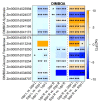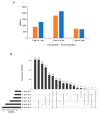Co-Transcriptomic Analysis of the Maize-Western Corn Rootworm Interaction
- PMID: 36145736
- PMCID: PMC9505089
- DOI: 10.3390/plants11182335
Co-Transcriptomic Analysis of the Maize-Western Corn Rootworm Interaction
Abstract
The Western corn rootworm (WCR; Diabrotica virgifera virgifera) is an economically important belowground pest of maize. Belowground feeding by WCR is damaging because it weakens the roots system, diminishes nutrient uptake, and creates entry points for fungal and bacterial pathogens and increases lodging, all of which can significantly suppress maize yields. Previously, it was demonstrated that belowground herbivory can trigger plant defense responses in the roots and the shoots, thereby impacting intraplant communication. Although several aspects of maize-WCR interactions have been reported, co-transcriptomic remodeling in the plant and insect are yet to be explored. We used a maize genotype, Mp708, that is resistant to a large guild of herbivore pests to study the underlying plant defense signaling network between below and aboveground tissues. We also evaluated WCR compensatory transcriptome responses. Using RNA-seq, we profiled the transcriptome of roots and leaves that interacted with WCR infestation up to 5 days post infestation (dpi). Our results suggest that Mp708 shoots and roots had elevated constitutive and WCR-feeding induced expression of genes related to jasmonic acid and ethylene pathways, respectively, before and after WCR feeding for 1 and 5 days. Similarly, extended feeding by WCR for 5 days in Mp708 roots suppressed many genes involved in the benzoxazinoid pathway, which is a major group of indole-derived secondary metabolites that provides resistance to several insect pests in maize. Furthermore, extended feeding by WCR on Mp708 roots revealed several genes that were downregulated in WCR, which include genes related to proteolysis, neuropeptide signaling pathway, defense response, drug catabolic process, and hormone metabolic process. These findings indicate a dynamic transcriptomic dialog between WCR and WCR-infested maize plants.
Keywords: Mp708; RNA-seq; Transcriptome; Western Corn Rootworm; maize.
Conflict of interest statement
The authors declare no conflict of interest.
Figures








References
-
- Dun Z., Mitchell P.D., Agosti M. Estimating Diabrotica virgifera virgifera Damage Functions with Field Trial Data: Applying an Unbalanced Nested Error Component Model. J. Appl. Entomol. 2010;134:409–419. doi: 10.1111/j.1439-0418.2009.01487.x. - DOI
-
- Tinsley N.A., Estes R.E., Gray M.E. Validation of a Nested Error Component Model to Estimate Damage Caused by Corn Rootworm Larvae. J. Appl. Entomol. 2013;137:161–169. doi: 10.1111/j.1439-0418.2012.01736.x. - DOI
-
- Branson T. Methods for the Study of Pest Diabrotica. Springer; New York, NY, USA: 1986. Larval Feeding Behavior and Host—Plant Resistance in Maize; pp. 159–182.
-
- Chiang H.C. Bionomics of the Northern and Western Corn Rootworms. Annu. Rev. Entomol. 1973;18:47–72. doi: 10.1146/annurev.en.18.010173.000403. - DOI
LinkOut - more resources
Full Text Sources

